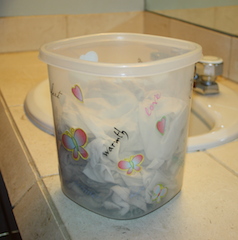Verefina DIY: Reusable Sanitizing Wipes
Posted by Katie Zapotoczny on 30th Mar 2016
 Disposable disinfectant wipes are so handy and convenient, aren’t they? If you’re like many Americans, you may keep them around for those occasions that require a quick cleaning. I’ll admit that I have used them. There are several reasons, though, to consider switching to a safer, more eco-friendly alternative.
Disposable disinfectant wipes are so handy and convenient, aren’t they? If you’re like many Americans, you may keep them around for those occasions that require a quick cleaning. I’ll admit that I have used them. There are several reasons, though, to consider switching to a safer, more eco-friendly alternative.
First, day to day cleaning done in the home does not generally require the harsh disinfecting chemicals that are contained in many of these wipes. Typically, removing- rather than killing- germs on surfaces is sufficient. While there are times that it may be necessary to disinfect, there are safer ways of doing so (more on that later).
Second, the synthetic chemicals found in many sanitizing wipes are often actually pesticides (source) that can trigger asthma and/or allergies (source).
Third, many wipes do not work as claimed unless they are used properly. For example, disinfectants may need to remain on a surface for an average of 4 to 10 minutes to kill all germs there. Ensuring that the surface stays wet for this amount of time may require the use of numerous wipes. Using these products incorrectly can also contribute to “superbugs,” as the germs left behind can become resistant to disinfectant chemicals.
Finally, sanitizing wipes are meant to be thrown away after one use, so they contribute to the amount of waste going into landfills. Wipes made by more eco-conscious companies have fewer chemicals in them, but they’re still usually intended to be thrown away.
Fortunately, it's pretty simple to make your own sanitizing wipes for cleaning. These DIY Reusable Sanitizing Wipes help cut back on household waste and are perfect for those quick cleaning jobs. Rather than synthetic disinfectants, they are made with Castile soap and essential oils known for their antimicrobial properties. For example, rosemary and clove essential oils have been found to inhibit Staph, Candida albicans, and E. coli in a lab setting; these oils are even more effective when used in combination (source). And a compound in oregano essential oil, carvacrol, has exhibited the ability to break down the outer protein layer of norovirus, the virus responsible for most cases of the “stomach bug” in the U.S. (source).
Here's how to make these reusable wipes.
Supplies:
* t-shirt or towel, cut into 4×4 or 5×5-inch squares
* 1 cup Castile soap
* 30 drops essential oil (lavender, lemon, rosemary, tea tree, oregano, clove all work well; use individually or in combination)
* container for storing the wipes
Directions:
* Add 30 drops (total) of essential oils to one cup of Castile soap. Stir gently to mix.
* Place the cut-up t-shirt or towel pieces in the container, and pour the soap mixture over them. Make sure all pieces are thoroughly moistened.
* Use on counters, walls, doorknobs, computer keyboards, or other hard surfaces that need a quick cleaning.
* Wash the wipes in hot water, dampen with the soap solution, and REUSE!
Sources:
Boyle, Megan. “The Trouble with Disinfecting Wipes.” EWG. 2 September 2015. Web. 23 March 2016.
http://www.ewg.org/enviroblog/2015/09/trouble-disinfecting-wipes
“Could Pizza Herb Prevent Winter Vomiting Disease?” EurekAlert!. 11 February 2014. Web. 12 November 2015.
http://www.eurekalert.org/pub_releases/2014-02/w-cph021014.php
“Don’t Wipe Out: The Hidden Hazards of Antibacterial Wipes.” EWG. 21 September 2012. Web. 23 March 2016.
http://www.ewg.org/enviroblog/2012/09/dont-wipe-out-hidden-hazards-antibacterial-wipes
Fu Y, Zu Y, Chen L, Shi X, Wang Z, Sun S, Efferth T. “Antimicrobial activity of clove and rosemary essential oils alone and in combination” PubMed. October 2007. Web. 23 March 2016.
http://www.ncbi.nlm.nih.gov/pubmed/17562569
 About the Author
About the Author
Katie Zapotoczny is a Verefina Affiliate and the creator of An Ever Green Life, a blog that seeks to empower readers to make changes that will improve their health and help protect our environment.

